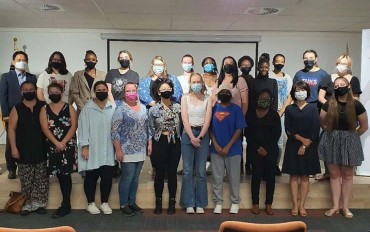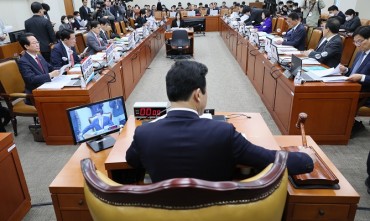
Samsung Noble County stands as a renowned silver town managed by the Samsung Life Insurance Foundation. Renowned for its popularity, this community exemplifies the essence of silver living. (Image from Samsung Noble County’s webpage)
SEOUL, Mar. 26 (Korea Bizwire) – As South Korea prepares for an unprecedented milestone of 10 million elderly citizens, the government has unveiled a sweeping set of measures aimed at enhancing housing options, improving care services, and fostering a supportive environment to meet the evolving needs of its rapidly aging demographic.
At the 22nd Public Life Discussion Forum held on March 21, policymakers detailed a comprehensive plan to reintroduce home ownership in senior housing communities, known as “Silver Towns,” while bolstering meal services at senior centers, institutionalizing hospital care assistance, and introducing “dementia primary care physicians.”
Addressing the pressing housing requirements, individuals aged 60 and above will be allowed to purchase residences in areas experiencing population decline. This revival eliminates previous restrictions and opens the market to a broader range of operators, including hotels, restaurants, insurance companies, real estate investment trusts (REITs), and long-term care facilities
To cater to low-income senior households, the supply of “Elderly Welfare Housing” will be tripled from the current 1,000 units per year to 3,000 units through new construction and remodeling projects. A portion of these units will be allocated through a lottery system, making them accessible to middle-income seniors as well.

Silver towns come in two distinct varieties: urban and rural, each offering unique advantages based on their location. Urban silver towns like The Classic 500 in Gwangjin-gu, Seoul, are tailored to cater to the needs of elderly residents who are actively engaged in work and enjoy frequent visits from their children. These urban hubs boast convenient access to transportation networks and essential amenities, reflecting the vibrant pace of urban life. (Image from the Classic 500 webpage)
Recognizing the diverse housing needs of the aging population, the government will also introduce a pilot program called “Silver Stay,” offering long-term rental housing options for middle-income seniors. In future urban developments, a designated portion of land will be allocated for senior-friendly housing to expand options for the elderly.
Enhancing access to adequate nutrition, a cornerstone of healthy aging, is another priority area. The government plans to increase the frequency of meal services offered at senior centers, upgrade infrastructure, and deploy safety managers at meal-serving centers starting next year.
Furthermore, underutilized spaces in apartment complexes and residential areas will be repurposed to facilitate self-pay meal services, with the government offering tax incentives to encourage such initiatives. This move is inspired by successful breakfast service programs in some apartment communities.
Ensuring access to quality care is another pillar of the government’s strategy. Starting next month, a pilot program will be launched to provide hospital care assistance, leading to the gradual institutionalization of this service by 2026. Standard guidelines, training programs, and a registration system will be established to improve the quality of care in this market.
To enhance access to home-based care for mobility-impaired seniors, the number of “Home Healthcare Centers” offering at-home medical services will grow from the current 95 to 250 by 2027, while out-of-pocket costs for home visits by doctors treating severe illnesses will be reduced.
In July, “Integrated Home Nursing Centers” will be introduced to provide a range of home nursing services to discharged patients. New service offerings tailored to the needs of seniors and their families, such as hospital accompaniment, will also be developed.

In a heartwarming tradition, children adorned in traditional hanboks from a nearby daycare center pay respects to their elders at a local senior center. This cherished practice of intergenerational bonding is a common sight before traditional holidays, symbolizing the deep-rooted respect and connection between generations. (Image courtesy of Yonhap)
With the growing prevalence of dementia, the government will introduce “Dementia Management Primary Care Physicians” through a pilot project starting in July. These specialists will provide comprehensive support, addressing both dementia and overall health concerns.
To assist seniors in seamlessly transitioning back to daily life after hospital discharge, an integrated support system will be established through pilot programs. This will include collaboration between support centers and services tailored to the needs of those with limited mobility.
Recognizing the importance of social inclusion and active living, the government plans to expand “Senior-Friendly National Sports Centers,” promote park golf, support the deployment of senior exercise instructors, and develop tailored exercise programs and information campaigns to foster healthy lifestyles among the elderly population.
Furthermore, efforts will be made to provide sustainable employment opportunities, with the goal of enabling 10% of the elderly population to consistently engage in work.
Particularly noteworthy is the initiative to conduct a comprehensive survey of seniors involved in waste paper collection, offering them alternative employment options and connecting them with health and welfare services.
Finally, to bridge the digital divide, the government will amend the Elderly Welfare Act to enhance accessibility to kiosks, mobile applications, and other digital devices through education, outreach, and promotional efforts tailored to the elderly demographic.
M. H. Lee (mhlee@koreabizwire.com)






